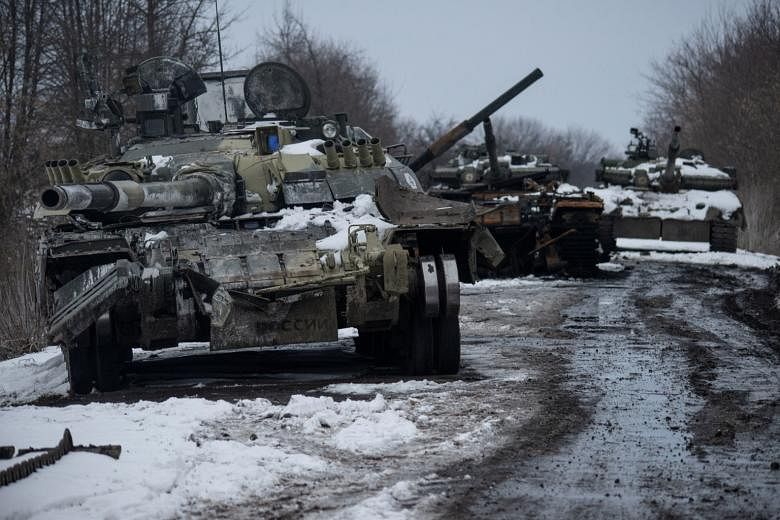WASHINGTON (NYTIMES) - In 36 days of fighting on Iwo Jima during World War II, nearly 7,000 Marines were killed. Now, 20 days after President Vladimir Putin of Russia invaded Ukraine, his military has already lost more soldiers, according to US intelligence estimates.
The conservative side of the estimate, at more than 7,000 Russian troop deaths, is greater than the number of US troops killed over 20 years in Iraq and Afghanistan combined.
It is a staggering number amassed in just three weeks of fighting, US officials say, with implications for the combat effectiveness of Russian units, including soldiers in tank formations.
Pentagon officials say a 10 per cent casualty rate, including dead and wounded, for a single unit renders it unable to carry out combat-related tasks.
With more than 150,000 Russian troops involved in the war in Ukraine, Russian casualties, when including the estimated 14,000 to 21,000 injured, are near that level. And the Russian military has lost at least three generals in the fight, according to Ukrainian, Nato and Russian officials.
Pentagon officials say that a high, and rising, number of war dead can destroy the will to continue fighting.
The result, they say, has shown up in intelligence reports that senior officials in the Biden administration read every day: One recent report focused on low morale among Russian troops and described soldiers just parking their vehicles and walking off into the woods.
The US officials, who spoke on the condition of anonymity to discuss operational matters, caution that their numbers of Russian troop deaths are inexact, compiled through analysis of the news media, Ukrainian figures (which tend to be high, with the latest at 13,500), Russian figures (which tend to be low, with the latest at 498), satellite imagery and careful perusal of video images of Russian tanks and troops that come under fire.
US military and intelligence officials know, for instance, how many troops are usually in a tank, and can extrapolate from that the number of casualties when an armoured vehicle is hit by, say, a Javelin anti-tank missile.
The high rate of casualties goes far to explain why Russia's much-vaunted force has remained largely stalled outside of Kyiv, Ukraine's capital.
"Losses like this affect morale and unit cohesion, especially since these soldiers don't understand why they're fighting," said Ms Evelyn Farkas, the top Pentagon official for Russia and Ukraine during the Obama administration. "Your overall situational awareness decreases. Someone's got to drive, someone's got to shoot."
But, she added, "that's just the land forces."
With Russian ground forces in disarray, Mr Putin has increasingly looked to the skies to attack Ukrainian cities, residential buildings, hospitals and even schools. That aerial bombardment, officials say, has helped camouflage the Russian military's poor performance on the ground.
President Volodymyr Zelenskyy of Ukraine said this week that an estimated 1,300 Ukrainian soldiers had been killed in the war.
Signs of Russia's challenges abound. Late last week, Russian news sources reported that Mr Putin had put two of his top intelligence officials under house arrest.
The officials, who run the Fifth Service of Russia's main intelligence service, the FSB, were interrogated for providing poor intelligence before the invasion, according to Mr Andrei Soldatov, a Russian security services expert.
"They were in charge of providing political intelligence and cultivating networks of support in Ukraine," Mr Soldatov said in an interview. "They told Putin what he wanted to hear" about how the invasion would progress.
Russians may be hearing only what Mr Putin wants them to hear about his "operation" in Ukraine, which he refuses to call a war or an invasion. Since it began, he has exerted iron control over the news outlets in Russia; state media is not publicising most casualties and has minimised the destruction.
But some Russians have access to virtual private networks (VPNs) and are able to get news from the West.
The news of the generals' deaths is trickling out, first from Ukrainians, then confirmed by Nato officials, with one death acknowledged by Mr Putin in a speech.
They have been identified as Major General Andrei Kolesnikov, a commander from Russia's eastern military district; Maj Gen Vitaly Gerasimov, first deputy commander of the 41st Combined Arms Army; and Maj Gen Andrei Sukhovetsky, deputy commander of the 41st Combined Arms Army.
Western officials say about 20 Russian generals were in Ukraine as part of the war effort and that they may have pushed closer to the front to boost morale.
"Three generals already - that's a shocking number," Mr Michael McFaul, former US ambassador to Russia, said in an interview.
On Wednesday (March 16), Ukrainian officials reported that a fourth general, Maj Gen Oleg Mityaev, commander of the 150th motorised rifle division, had been killed in fighting.
Two US military officials said many Russian generals are talking on unsecured phones and radios. In at least one instance, they said, the Ukrainians intercepted a general's call, geolocated it and attacked his location, killing him and his staff.
If Russian military deaths continue to rise, the kinds of civic organisations that called attention to troop deaths and injuries during the Soviet invasion of Afghanistan could once more come to prominence.
But the Russian toll, some military specialists and lawmakers say, is unlikely to change Mr Putin's strategy.
"It is stunning, and the Russians haven't even gotten to the worst of it, when they hit urban combat in the cities," Representative Jason Crow, a member of the House Armed Services and Intelligence committees, said in an interview.
"I don't think it'll have an impact on Putin's calculus," Mr Crow said. "He is not willing to lose. He's been backed into a corner and will continue to throw troops at the problem."

